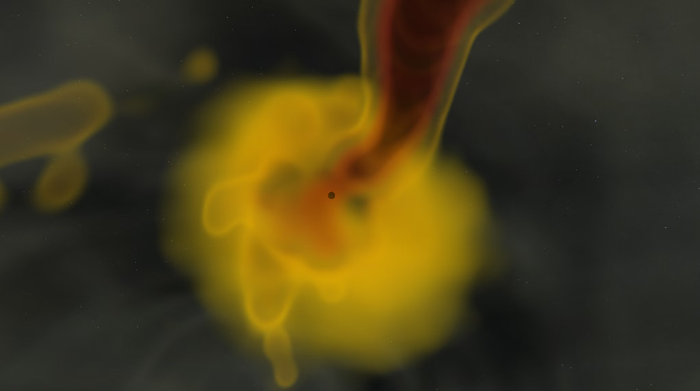Astronomers from the Flatiron Institute’s Center for Computational Astrophysics (CCA) and colleagues have determined how these black holes formed and collided. The findings appeared in The Astrophysical Journal Letters.
 A still image from a computer simulation of a black hole’s formation and evolution. Image Credit: Ore Gottlieb/Simons Foundation
A still image from a computer simulation of a black hole’s formation and evolution. Image Credit: Ore Gottlieb/Simons Foundation
In 2023, scientists spotted a massive collision. Two unprecedentedly enormous black holes collided an estimated 7 billion light-years away. Astronomers were puzzled by the black holes' large masses and extreme spins. Black holes like these weren’t expected to exist under current physics models.
The researchers' detailed simulations, which trace the system from the birth of the parent stars to their eventual demise, revealed a crucial piece that earlier studies had overlooked: electromagnetic fields.
No one has considered these systems the way we did; previously, astronomers just took a shortcut and neglected the magnetic fields. But once you consider magnetic fields, you can actually explain the origins of this unique event.
Ore Gottlieb, Study Lead Author and Astrophysicist, Center for Computational Astrophysics, Flatiron Institute
The LIGO-Virgo-KAGRA collaboration employed detectors that monitor gravitational waves (the ripples in space-time induced by the motions of large objects) to observe the 2023 collision, which is now known as GW231123.
Astronomers were unable to understand how such massive, rapidly rotating black holes came to be at the time. Many large stars collapse and explode as supernovae at the conclusion of their lifetimes, leaving behind a black hole.
However, a certain kind of supernova happens if the star is inside a certain mass range. The star is completely destroyed in this explosion, which is known as a pair-instability supernova.
As a result of these supernovae, we don’t expect black holes to form between roughly 70 to 140 times the mass of the sun. So it was puzzling to see black holes with masses inside this gap.
Ore Gottlieb, Study Lead Author and Astrophysicist, Center for Computational Astrophysics, Flatiron Institute
Black holes in this mass gap can arise indirectly when two black holes combine to produce a bigger black hole, but scientists believed this was unlikely in the case of GW231123. The merger of black holes is a very turbulent phenomenon that frequently disturbs the rotation of the new black hole.
The black holes in GW231123 were the fastest spinners observed by LIGO, pulling space-time around them at almost the speed of light. Two black holes of this size and spin are extremely unusual, therefore astronomers concluded that something else was at work.
Gottlieb and his collaborators investigated by running two sets of computational simulations. They first simulated a huge star 250 times the mass of the sun during its primary stage of life, from when it begins to burn hydrogen to when it runs out and explodes in a supernova.
By the time a big star reached the supernova stage, it had burnt through enough fuel to reduce its mass to only 150 times that of the sun, placing it just over the mass gap and large enough to leave a black hole behind.
A second set of more complicated simulations, which included magnetic fields, addressed the supernova's aftermath. The concept began with supernova leftovers, which are a cloud of leftover stellar debris laced with magnetic fields and a black hole at the core.
Previously, scientists considered that the whole mass of the cloud would collapse into the newborn black hole, bringing the black hole's total mass to that of the enormous star. But the simulations revealed something different.
When a nonrotating star collapses to become a black hole, the remaining detritus swiftly falls into the black hole. However, if the initial star was rotating quickly, this cloud creates a spinning disk, causing the black hole to spin faster and faster as material falls into its abyss. Magnetic fields exert pressure on the debris disk. This pressure is powerful enough to propel some material away from the black hole at almost the speed of light.
These outflows diminish the amount of material in the disk, which finally feeds into the black hole. The more powerful the magnetic fields, the greater the impact. In extreme instances with very high magnetic fields, up to half of the star's original mass can be expelled by the black hole's disk ejecta. In the simulations, the magnetic fields resulted in a final black hole in the mass gap.
We found the presence of rotation and magnetic fields may fundamentally change the post-collapse evolution of the star, making black hole mass potentially significantly lower than the total mass of the collapsing star.
Ore Gottlieb, Astrophysicist, CCA and Study Lead Author, Flatiron Institute
According to Gottlieb, the findings point to a connection between a black hole's mass and its spin rate. Strong magnetic fields may slow down a black hole and remove part of the stellar mass, resulting in lighter, slower spinning black holes.
Weaker fields allow for heavier, faster-spinning black holes. This shows that black holes may follow a pattern that relates their mass and spin together. While astronomers are aware of no other black hole systems on which this relationship may be observed, they expect that future observations will reveal other such systems, confirming this connection.
The simulations also demonstrate that the development of these black holes results in gamma ray bursts, which could be observable. The search for these gamma ray signals would assist in corroborating the proposed development process and disclose how frequent these massive black holes are in the universe. Finally, if such a relationship is established, astronomers will acquire a better grasp of the underlying physics of black holes.
Journal Reference:
Gottlieb, O., et al. (2025) Spinning into the Gap: Direct-horizon Collapse as the Origin of GW231123 from End-to-end General-relativistic Magnetohydrodynamic Simulations. The Astrophysical Journal Letters. DOI 10.3847/2041-8213/ae0d81. https://iopscience.iop.org/article/10.3847/2041-8213/ae0d81.